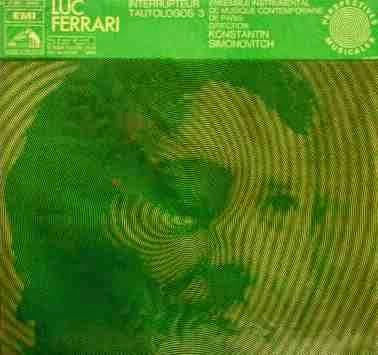Interrupteur / Tautologos 3 (1970) ...
Orchestra with tape pieces from French composer Luc Ferrari ...Conductor Konstantin Simonovitch
Orchestra Ensemble Instrumental de Musique Contemporaine
Interrupteur ...
Ferrari has time and again ranged far afield of musique concrète, and Interrupteur/Tautologos 3 is one such foray into instrumental music. These particular realizations came about through Ferrari's directed improvisations of Konstantin Simonovitch's ensemble, and the recordings were originally released in 1970 by EMI in their 'Perspectives Musicales' series. 'Interrupteur' is largely static music, a music of long tones periodically interrupted by aleatoric events. If it references musical minimalism (particularly Terry Riley, Steve Reich, and Robert Ashley), this surely counts as an intuitive, very personal result.
Tautologos 3 (Part 5) ...
'Tautologos 3' pursues the idea of the superposition of cycles of different lengths that, once set into motion, will continually result in new events.
'Interrupteur' is from 1967 and features the following instrumentation: English horn, clarinet, bass clarinet, French horn, trumpet, violin, viola, cello, two percussions, two electric organs. It is one of the most outright powerful and devastating recordings within the avant garde realm. "Tautologos 3" is from 1970 and features: flute, oboe, clarinet, trumpet, trombone, viola, cello, double bass, electric guitar, electric organ & vibraphone... boomkat.com ...
Buy Stuff !! ...
"Tautologos 3" from 1970 is going to be reissued by David Grubbs. Is he going to re-record the piece or use Simonovic's original performance?
They're going to reissue the original. Which isn't bad, actually... it's fun. "Tautologos 3" is another story, one which inevitably puts me in line with the American minimalists. I think I already knew their music-around 1970 I went to the States and met Steve Reich, Terry Riley, Robert Ashley, Gordon Mumma... I like these guys a lot. Maybe the idea was already there. When was "In C"? 1964? I couldn't say I was a minimalist at the time, but I was always interested in repetition: I just didn't know how to tackle it. I was tied up in serialism in the 60s, but even so I was experimenting with loops which repeated in cycles which never met up-that was also the idea of the "Music Promenade" installation we talked about: Musical events where you perceive the idea of repetition without them being necessarily repetitive themselves.
What interested me was looping the events in such a way that each time they reappeared, they created new musical objects. The idea of tautology. The first "Tautologos 3" was a written score, a text-score (like many others at that time), where I explained the rules of the tautology; it was a score which gave individual players the freedom to choose their action. We did this version a lot, in instrumental and theatrical contexts. Well, what with mixing up other people's instrumental and theatrical actions, after a while I wanted to do my version of the piece! (Laughs) So I wrote an instrumental score which respected the demands of the text-score. From time to time I taught workshops where I did "Tautologos 3" very often, with the students having to follow the score quite closely-so when I showed them my own version they said: "You're cheating! You're not following the rules!" And I said: "I am free, you know..."
The other piece on the CD is "Interrupteur". What were you trying to do with in that work?
I wanted to write the most static music possible. I suppose it didn't work out, as it's quite a busy score! (Laughs) The idea was to have instrumental continuities which went from beginning to end. One instrument goes up for ten minutes and comes down for ten minutes, while another goes up for three minutes and comes down over the next seventeen, and so on. Each instrument had its plan and there were lines which crossed, and each time that happened there was a special event. That was the basic idea. What interested me was to decide on a duration and to see what each instrument was going to do, in a conceptual way. I'm starting to work with durations again, trying to organise them in a completely aleatoric way interms of the composition; it's all written out, but the compositional information is all generated by chance. I take the duration and use it as a painter would, like a canvas... Interview with Luc Ferrari (doc, Dan Warburton, 1998) ...

No comments:
Post a Comment